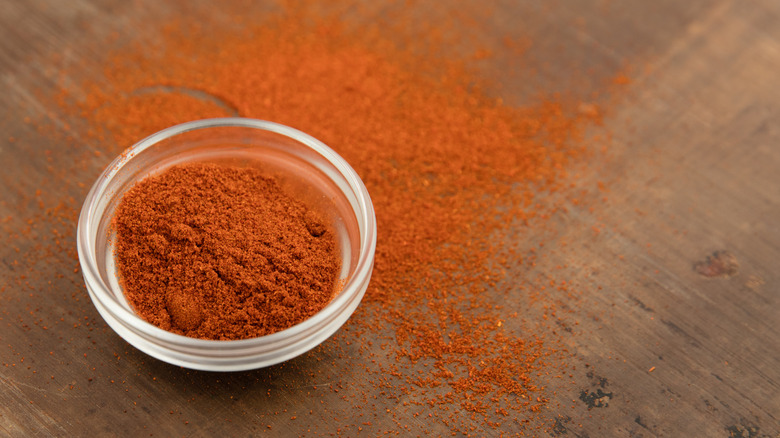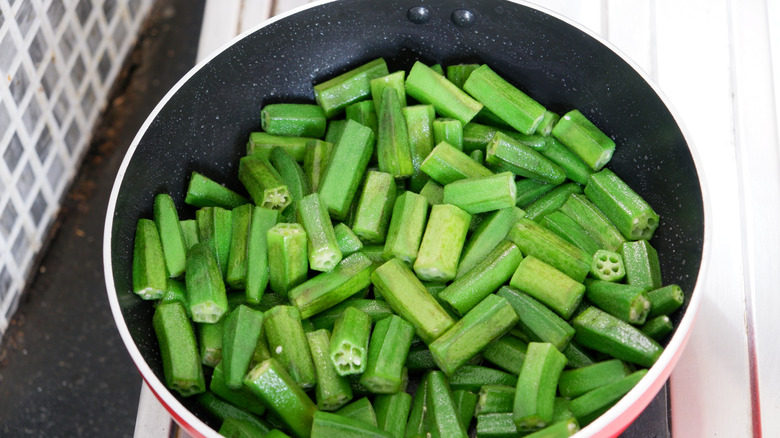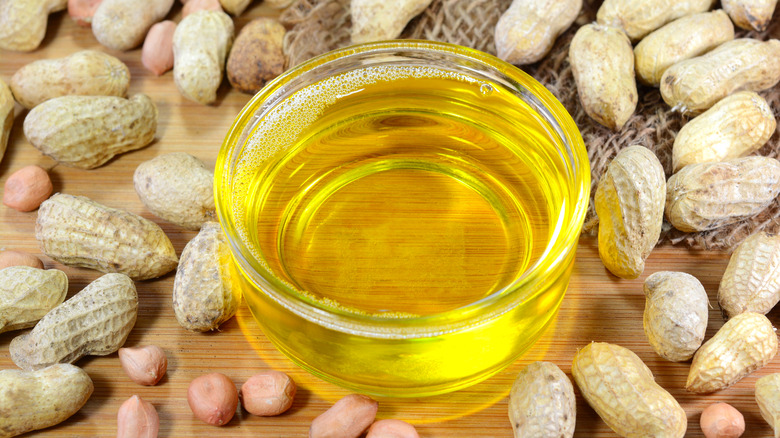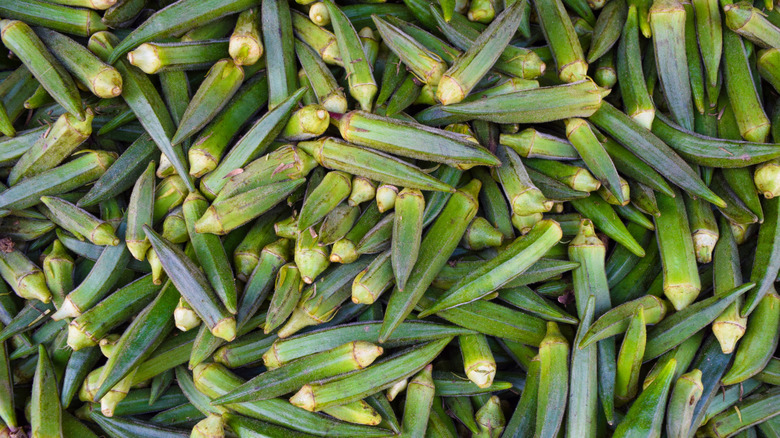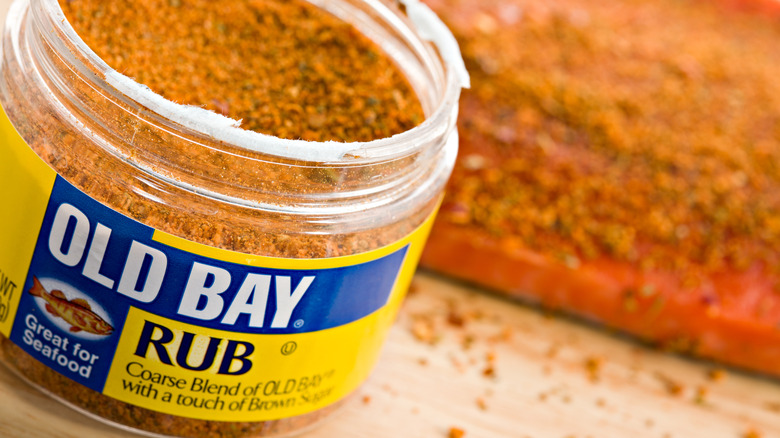11 Ways To Elevate Fried Okra
Oftentimes, vegetables are relegated to forgotten side dishes, add-ons to the main course, which is, many times, meat-based. But true veggie lovers know that an especially tasty vegetable-forward dish can totally steal the spotlight on the dinner table — even when a big hunk of protein is involved. One vegetable dish that can play a starring role on any table is fried okra. The Southern classic is widely beloved as a crispy side dish (and maybe the most delicious way of getting more greens into your diet).
Whether you've made fried okra countless times in your life or you're trying to fry some up for the first time ever, there are some easy steps you can take to elevate the basic version of the dish into something really, really special. Don't be surprised if everyone at the table forgets about the main course entirely and loads up on your upgraded fried okra instead. Here's how to take your standard recipe to a whole new level.
Pan fry your okra instead of deep frying it for a lighter dish
Have you ever gotten a dish of fried okra that was so fatty and oily, you could barely stomach it? Yeah, you're not alone. Unfortunately, it's a common problem a lot of fried food lovers run into from time to time. But if you're making fried okra at home and want to avoid that depressing fate, there's one easy step you can take: deciding to pan fry your okra instead of deep frying it.
The most appealing aspect of pan fried okra is the fact that it uses a lot less oil than the deep-fried version. This is great news if you want to cut down on the fattiness in your meal or you just want to avoid those unsightly oil splatters all over your freshly cleaned range. Additionally, this method ensures ultra-crispy okra, so you don't have to worry about any of that sogginess getting in the way of your enjoyment of the dish. Pan frying your okra makes it both more delicious and easier to make, so what's not to love? Give this method a try the next time you're craving homemade fried okra.
Combine your fried okra with a creamy dressing
Fried okra is very singular in its texture. It's crispy and fatty, with a richness that's delicious on its own but even better when it's paired with a complementary dip. That's why you may want to consider making a creamy dressing to go with your okra. One of Tasting Table's recipes from Troy MacLarty calls for okra to be served with the Indian condiment raita. This condiment is made from full fat Greek yogurt along with cucumber, cilantro, and lime juice, among other ingredients. It provides the ideal counterpoint to okra's crispy texture. Plus, that light, bright texture really tones down the fried food's intensity, making for a more balanced bite.
But you don't have to stick to raita if you don't want to. Tzatziki is a similar creamy sauce that would work really well here, especially if you like that cucumber-forward flavor. But if you want to keep things really simple, you can just use some bottled, store-bought ranch dressing. Even plain mayo can elevate an otherwise basic fried okra dish. Once you've tasted fried okra with the creamy element of your choice, you may never go back to the side dish in its naked version again.
Soak your okra in vinegar before breading it for less sliminess
One complaint that a lot of people have about okra is the fact that it can be quite slimy. Now, some people love that slimy texture — after all, it offers an interesting mouthfeel you're not going to get from many other foods. However, a lot of others absolutely hate it, and it's the reason they avoid this otherwise delicious vegetable. If you fall into the latter category, you should know that there are some steps you can take to cut down on that slimy, undesirable texture. One of the simplest ways to do that is to simply soak your okra in vinegar before you bread it and fry it.
So, how exactly does this work? Basically, the acid in vinegar breaks down the gelatinous substance in okra that makes it so slimy. After just a few minutes in that vinegar, and you'll notice that a lot of that texture is gone from the okra. Of course, if that slimy texture doesn't bother you, then this is a step you may be willing to skip. But if the only thing keeping you from adoring fried okra is the slimy quality, then a quick vinegar soak may be the key to making you fall in love with this Southern veggie staple.
Use an air fryer to make your fried okra
When you think of fried okra, you probably think of okra that's been deep fried or at least pan fried. But these days, there are more ways to achieve that crispy texture we all love from fried okra. If you're looking for a quick, easy, and less oily way to make fried okra at home, you may want to consider using your air fryer. Yes, we know Southern grandmas everywhere are clutching their pearls, but hear us out: Just because it's not the traditional way of doing things doesn't mean it won't yield delicious results.
First of all, you're going to want to bread your fried okra like normal, using a cornmeal or cornmeal and flour mixture. One way to ensure that extra crunch that you get from traditional fried okra, though, is to toast the breading mixture before you actually apply it to the okra. That way, it already boasts some crispiness before you crisp it even further in the air fryer. We love this method for cooking fried okra because it's lighter than its traditional counterparts, and it's a pretty hands-off process — perfect for those nights when you're just trying to whip up a quick side dish.
Give your cornmeal or flour breading a kick of heat from cayenne
Check out some fried okra recipes online, and you'll find that most breading recipes are pretty standard. Many, if not most, recipes call for fine yellow cornmeal and/or flour, which forms the basis of your breading. You may be instructed to add salt and pepper to the breading mixture, but those two ingredients may not provide you with as much flavor as you want in your fried okra. If that's the case, it's time to look through the spice cabinet to see what else you can add. And if you're as much of a spicy food lover as we are, then there's one ingredient you definitely don't want to leave out: cayenne pepper.
Cayenne pepper can make for a delicious addition to an otherwise standard fried okra recipe because it provides a touch of heat you're not going to be getting from the other ingredients. However, by adding just a bit of cayenne pepper, that spice isn't going to be overwhelming — it's just going to give the breading that slight heat and complexity that elevates the whole dish. Unless you're super opposed to spicy foods, give it a try the next time you're making the breading for your fried okra.
Cook it at a high heat to reduce sliminess
We've already talked about soaking your okra in vinegar to get rid of that slimy texture, but there are other ways to cut down on the slime and achieve the fried okra texture you're going for. Another simple way of solving this issue is by cooking your fried okra on high heat. This is because the longer you cook okra for, the slimier it becomes. Therefore, by hitting it with high heat right away, you're able to cook it as quickly as possible, cutting down on the time it sits in the pan just getting slimier. Plus, it also helps you achieve that crispy breading that you're going for anyway.
For best results, you can both soak your okra in vinegar and then cook it on high heat. Even if you skip the vinegar altogether, though, you should be cooking your fried okra on high heat anyway. Whether you pan fry or deep fry it is up to you — either way will work.
Use peanut oil for a different oil flavor profile
Canola oil is considered a neutral oil, which means it has very little flavor to it. This is one reason why many recipes call for canola oil in place of, say, olive oil, which has a much stronger, more distinct flavor to it. But some people swear that canola oil has a distinct flavor, and these people often find that flavor unpleasant. If canola oil has never bothered you before, then you can go ahead and use it to fry your okra. On the other hand, if you fall into the camp of people who don't particularly like the flavor of canola oil, then you may be looking for an alternative. Luckily, peanut oil is here to save the day.
Peanut oil is also a neutral oil, so it's a safe bet for cooking your fried okra. Some consider it to have a slight nutty flavor to it, which can enhance your fried okra if you like that flavor. Ultimately, whether you decide to use canola or peanut oil is up to you. But to switch things up, we recommend giving peanut oil a try. It may just become one of your new favorite cooking oils.
Let your okra dry before frying it
If there's one thing you should know about frying in general, it's that you don't want to put anything too wet into the pan. Of course, this helps avoid painful oil splatters and can even prevent kitchen fires. But dry ingredients also fry better, leaving you with that crisp texture you're trying to achieve rather than a soggy mess. That rule stands true with okra especially, since it naturally has so much moisture. Therefore, your best bet is to dry that okra out before you start the frying process.
There are two different ways to do this. If you're in a hurry, after you've chopped your okra, you can simply blot it off with a paper towel. This will yield drier results in less time. However, if you do have some extra time to spare, you can let the okra air dry for a while. Either method will achieve similar results — crispier fried okra. Plus, you can worry less about those oil splatters making your kitchen countertops dirty.
Make sure you pick the freshest okra possible
Most cooking tips — including those for fried okra — will tell you about steps you can take when you're already in the kitchen getting ready to cook. But in reality, the most important step you can take actually takes place way before you even get in the kitchen. For the best, most delicious results in any dish, you want to make sure you're getting the freshest, highest-quality produce. But unless you buy fresh okra all the time, you may not know exactly what you're looking for. Luckily, we have a few tips for you when it comes to shopping for okra.
One of the best ways to pick super fresh okra is to pay attention to its color. Look for okra that's a bright, vibrant green, as this stuff is likely to be quite fresh. Try to avoid pieces of okra that have bruises or brown spots, as these may indicate that the vegetable doesn't taste its best. Additionally, you should pay attention to the size of the okra. Smaller okra tend to be more tender, while larger okra can be tough and fibrous. Opt for the former, ideally 4 inches or under, when you're shopping for fresh okra. And before you put that okra in your cart, give it a squeeze. It should feel firm and springy. If it's too soft or mushy, it's probably past its prime.
Cut the okra into very thin slices for the crispiest result
You've taken all the necessary steps to ensure that your okra is as crispy as possible: You've soaked it in vinegar, let it dry, and even have it destined for a particularly thick breading. But still, once you've actually fried it all up, it's still soggier than you hoped for. If you've been in this position before, you're not alone. There's one more line of defense to prevent that soggy okra bite, and it may just be the most important: cutting your okra into very thin slices.
Perhaps you're tempted to cut your okra into big chunks so you get a good mouthful with every bite. But by cutting it into thinner slices, you're ensuring you're coating more of the okra in that breading, which helps to make it as crispy as possible. This simple step will just take you a few extra minutes, but the payoff is immeasurable. Make sure to attempt those teeny-tiny slices the next time you decide to make fried okra.
Add some Old Bay to your breading mixture
Sometimes, it pays to think of ingredients in unique ways. For example, you may think of Old Bay as a spice mixture used exclusively for seafood. In reality, though, you can use Old Bay for just about anything. And because it's such a flavorful mix of spices, it can work especially well as a way to flavor your fried okra breading mixture. Whether you're using cornmeal, flour, or a combination of both, adding some Old Bay to the breading can make a huge difference.
Take a look at the ingredient list for Old Bay, and you'll see that it contains spices like paprika, mustard, celery seed, coriander, thyme, basil, cayenne, and more. All of those spices come together to create a truly distinct flavor that tastes amazing on seafood, yes, but also in your fried okra breading. It may not be the same recipe your grandma used back in the day, but when you see how much Old Bay can add a kick of flavor to your okra, you'll never go back to unseasoned okra breading again.





